Seagate's Roadmap: The Path to 120 TB Hard Drives
by Anton Shilov on March 10, 2021 2:00 PM EST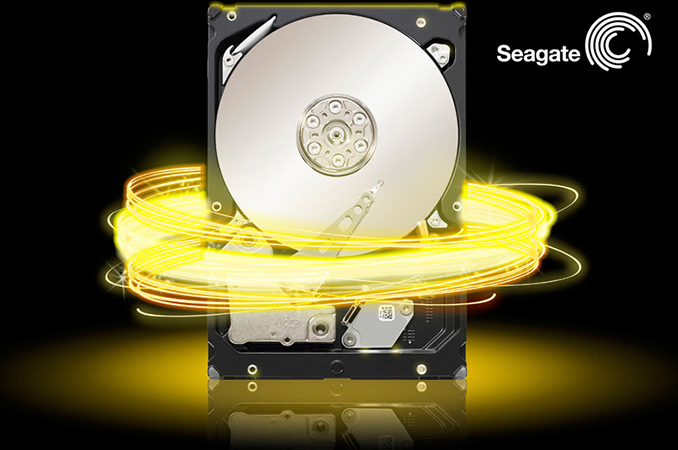
Seagate recently published its long-term technology roadmap revealing plans to produce ~50 TB hard drives by 2026 and 120+ TB HDDs after 2030. In the coming years, Seagate is set to leverage usage of heat-assisted magnetic recording (HAMR), adopt bit patterned media (BPM) in the long term, and to expand usage of multi-actuator technology (MAT) for high-capacity drives. This is all within the 3.5-inch form factor.
"We can use our recent experience, productizing our 20 TB HAMR drive to translate from laboratory demonstrations to products, which puts us on track to deliver 50 terabytes by 2026," said John Morris, Chief Technology Officer of Seagate. "We have drive technologies planned which will enable long term HAMR growth and a path to over 100 TB devices. And hard disk drives will continue to service the needs of mass capacity storage with the most optimal, total cost of ownership for the next decade and beyond."
HAMR to Enable 90 TB HDDs
In the recent years HDD capacity has been increasing rather slowly as perpendicular magnetic recording (PMR), even boosted with two-dimensional magnetic recording (TDMR), is reaching its limits. Seagate's current top-of-the-range HDD features a 20 TB capacity and is based on HAMR, which not only promises to enable 3.5-inch hard drives with a ~90 TB capacity in the long term, but also to allow Seagate to increase capacities of its products faster.
In particular, Seagate expects 30+ TB HDDs to arrive in calendar 2023, then 40+ TB drives in 2024 ~ 2025, and then 50+ TB HDDs sometimes in 2026. This was revealed at its recent Virtual Analyst Event. In 2030, the manufacturer intends to release a 100 TB HDD, with 120 TB units following on later next decade. To hit these higher capacities, Seagate is looking to adopt new types of media.
"As we approach the maximum useful capacity of PMR technology, each successive drive increases by 1TB or 2TB at a time," said Jeff Fochtman, Seagate's SVP of Business and Marketing at the company's Analyst Meeting. "With HAMR technology, it allows us to jump in steps of 4 terabytes, 6 terabytes, or even 10 terabytes at a time."
Today's 20 TB HAMR HDD uses nine 2.22-TB platters featuring an areal density of around 1.3 Tb/inch2. To build a nine-platter 40 TB hard drive, the company needs HAMR media featuring an areal density of approximately 2.6 Tb Tb/inch2. Back in 2018~2019 the company already achieved a 2.381 Tb/inch2 areal density in spinstand testing in its lab and recently it actually managed to hit 2.6 Tb/inch2 in the lab, so the company knows how to build media for 40 TB HDDs. However to build a complete product, it will still need to develop the suitable head, drive controller, and other electronics for its 40 TB drive, which will take several years.
Bit Patterned Media (BPM) to enable HDDs up to 120 TB
In general, Seagate projects HAMR technology to continue scaling for years to come without cardinal changes. The company expects HAMR and nanogranular media based on glass substrates and featuring iron platinum alloy (FePt) magnetic films to scale to 4 ~ 6 Tb/inch2 in areal density. This should enable hard drives of up to 90 TB in capacity.
In a bid to hit something like 105 TB, Seagate expects to use ordered-granular media with 5 ~ 7 Tb/inch2 areal density. To go further, the world's largest HDD manufacturer plans to use 'fully' bit patterned media (BPM) with an 8 Tb/inch2 areal density or higher. All new types of media will still require some sort of assisted magnetic recording, so HAMR will stay with us in one form or another for years to come.
"We see an opportunity to scale this design space with granular media into the range of 4 Tb/inch2 to 6 Tb/inch2, at which point we plan to add patterning in one dimension through the use of ordered grain media," said Morris. "This, we expect to be a steppingstone in media to open up the range of 5 Tb/inch2 to 7 Tb/inch2. Then we will transition to fully patterned media to open up densities to 8 Tb/inch2 and even higher. With the areal density CAGR just introduced, we have a path to 10TB per disk by 2030. This then represents our outlook for technology limits over the next 10 to 15 years."
Performance Improvements Included
Increasing the capacity of hard drives is extremely important to keep them competitive with solid-state drives, but in a bid to stay relevant for operators of cloud datacenters, HDDs also need to improve sequential and random performance.
Sequential performance of hard drives surges along with areal density, so we see gradual HDD performance bumps every year. But as the capacity of a drive increase, the random IOPS-per-TB performance drops, which requires operators of large datacenters to mitigate this with caches to maintain their Quality-of-Service, which means additional costs.
Seagate and Western Digital have been looking to radically increase sequential and random performance of HDDs by installing more than one actuator, with multiple read/write heads into one drive. Seagate's Mach.2 technology — which embraces two actuators — can almost double IOPS-per-TB performance of a hard drive and substantially increase its sequential read/write speeds. Furthermore, with two independent actuators, Seagate can almost halve the time it needs to test one drive before shipping, which reduces its manufacturing costs. The advantage of two actuators will become even more significant as HDD makers transit to platforms with more platters.
"A notable benefit to dual actuator technology standardization is that it drastically cuts down test time, and therefore, hard drive production time is greatly reduced," said Fochtman. "This is a benefit we're looking forward to recognizing on the cost side of the business."
There are about a dozen of customers that already use Seagate's Mach.2 PMR-based HDDs in their datacenters, although these drives do not have a commercial branding. Eventually, the company plans to make Mach.2 HDDs available to other clients, yet the company does not disclose when this is set to happen. However, the manufacturer is poised to use its Mach.2 technology more broadly once its drives hit capacities of above 30 TB, as drives with one actuator will not have sufficient performance, and a one-actuator design would increase the total cost of ownership.
"Although Mach.2 is ramped and being used now, it is also really still in a technology-staging mode," said Fochtman. "When we reach capacity points above 30 terabytes, it will become a standard feature in many large data center environments."
HDD TCO to Remain Low
Speaking of TCO, Seagate is confident that hard drives will remain cost-effective storage devices for many years to come. Seagate believes that 3D NAND will not beat HDDs in terms of per-GB cost any time soon and TCO of hard drives will remain at competitive levels. Right now, 90% of data stored by cloud datacenters is stored on HDDs and Seagate expects this to continue.
"We believe that the TCO for hard disk drives and SSDs will stay approximately in equilibrium," said Morris. "Both SSDs and hard disk drives will continue to improve their value proposition, and storage demand for both will continue to grow. They are both critical enabling technologies for the growing datasphere, and their synergistic relationship in the data center infrastructure will persist."
Related Reading
- Toshiba Unveils World's First FC-MAMR HDD: 18 TB, Helium Filled
- Western Digital Expands 18TB Purple Surveillance Storage
- Toshiba to Expand HDD Production: 20 TB & 10-Platter Drives Coming
- Demand for HDD Storage Booming: 240 EB Shipped in Q3 2019
- Seagate: 18 TB HDD Due in First Half 2020, 20 TB Drive to Ship in Late 2020
- Western Digital 20 TB HDD: Crazy Capacity for Cold Storage
- Toshiba's HDD Tech Roadmap: A Mix of SMR, MAMR, TDMR, and HAMR



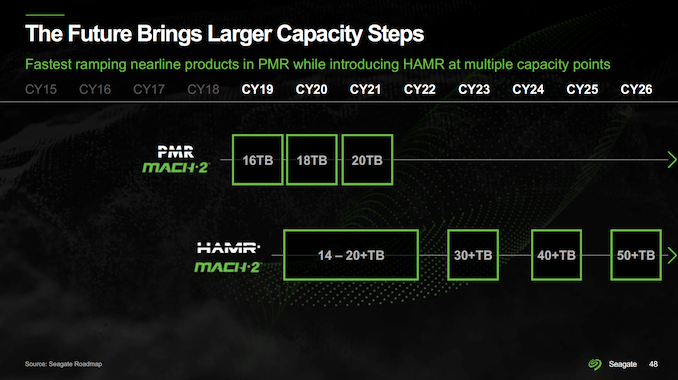
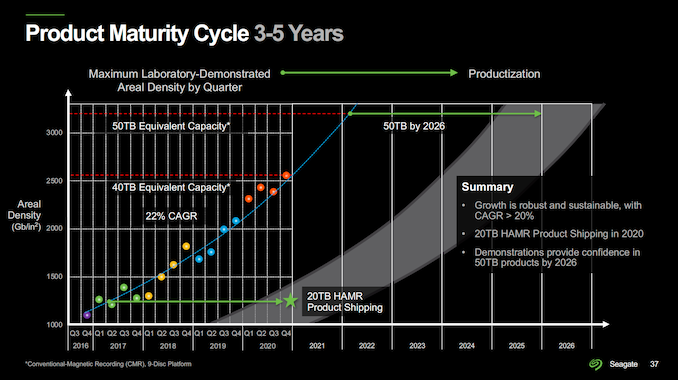
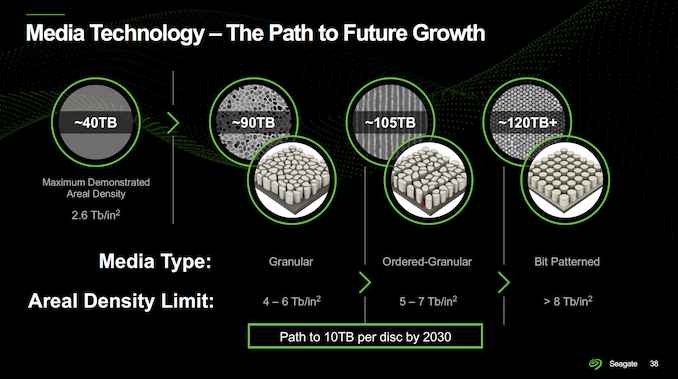
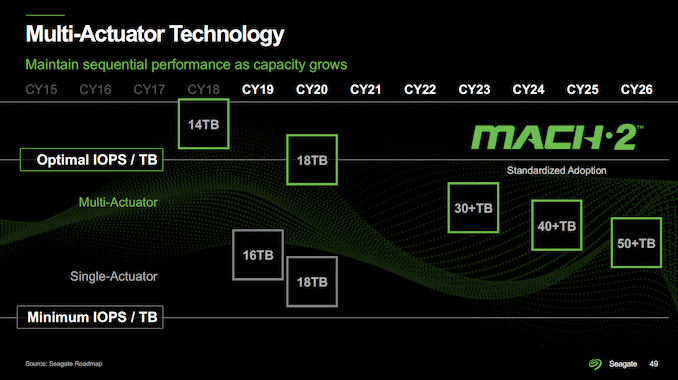
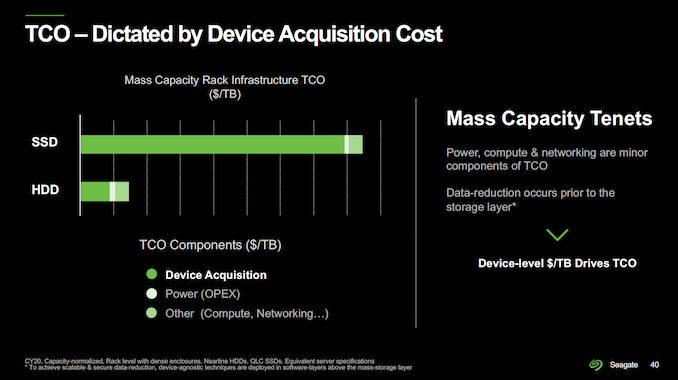
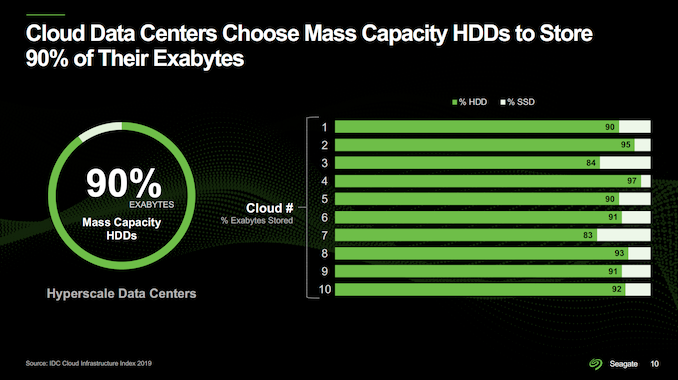








70 Comments
View All Comments
Samus - Friday, March 12, 2021 - link
The problem with SATA is the command set cannot be modified to have a lot of the advantages of NVMe (particularly reduced overhead and power efficiency) without losing compatibility with existing SATA drives. The queuing nature of SATA and block assignment requires a command structure that actually conflicts with those of NVMe and since it hasn't ever been courted as even a theoretical proof-of-concept within industry circle, I don't think it's possible or there just doesn't seem to be enough interest within the industry to bother.SAS has a great deal of performance and very low overhead as most of the work is offloaded to the drive controllers off the bus, enabling the host controller to manage queuing and RAID management. It will be "some time" before magnetic media exceeds 1.2GBps (and unlike SATA, SAS actually delivers nearly 100% of its available throughput. My guess is by the time magnetic media hits this kind of performance, a revised SCSI command set with a new interface will be introduced because they will need to keep it backward compatible if only for their data center partners, who effectively subsidize the hard disk industry for us casual consumers.
Samus - Friday, March 12, 2021 - link
Correction: The recently introduced SAS-4 supports 2.25GBps, which is backward compatible all the way to SAS-1, while still supporting 65,535 devices on the same bus, and SAS-5 is being developed around PCIe 4.0 to deliver 4.5GBps. Keep in mind these are all PER NODE and the limitation is really the PCIe bus. Even a common PCIe 3.0 8x SAS-3 RAID controller doesn't have enough throughput from 8 of the fastest current SAS drives to saturate the bandwidth provided by the 8x PCIe slot. So the real limitation is the bus if hard disks ever catch up and deliver near-NVMe SSD speed.beginner99 - Friday, March 12, 2021 - link
For home-use the good thing about lack of hdd performance was the lack of need to even need >1gbit/s Ethernet. Common low-power NAS drives barley break this limit in sustained read/wrtie.Wereweeb - Wednesday, March 10, 2021 - link
I assume that today that would increase energy consumption/heat output to intolerable levels. Not to speak of the reliability issues it would bring. Heck, right now they're probably still working on teething issues that the dual actuator tech might have.And while I'm sure that in the future we'll have something like that, they might end up reducing the number of platters in the drive to optimize for the total cost of ownership, which would partition the IOPS-optimized drives from cold nearline storage drives again.
And it still wouldn't really be "super fast", since files in general will grow much larger as everyone gets access to more and more storage. Imagine copying a 2TB game from an HDD, even one with a bucketton of actuators.
Multi-actuator tech is just a band-aid to maintain a respectable IOPS/TB metric for their server consumers - and it will still take a very long time to read through an entire 120TB HDD.
Kamen Rider Blade - Wednesday, March 10, 2021 - link
Seagate has already stated in a blog that having "Dual Actuators" only cost you 1x platter in density for each HDD.So if you would have a 10 Platter HDD with Single Actuator, a 9 Platter HDD could have Dual Actuators.
That's well worth the trade-off IMO.
vegemeister - Thursday, March 11, 2021 - link
Most of hard drive power/heat is from the spindle motor.Samus - Friday, March 12, 2021 - link
Not for long. I suspect these new platters are going to get VERY hot with HAMR literally heating up the surface. What's amazing is that heat will naturally be absorbed into the spindle and spread to the motor. It makes me wonder if a lot of enterprise drives using heat assisted recording will be 5000RPM-class drives.eastcoast_pete - Friday, March 12, 2021 - link
Aren't those HAMR platters based on a glass-like carrier substrate? I thought the whole idea of heat-assisted recording is the highly localized nature of the heating, so the absolute amount of power used for heating is actually quite low.ballsystemlord - Wednesday, March 10, 2021 - link
I agree! Maybe we can get HDD's that have lower latency random I/O than QLC SSDs.eastcoast_pete - Wednesday, March 10, 2021 - link
Yes, and if they go to 8 arms they could call those their "Kraken " line of drives. At least the name would be catchy.